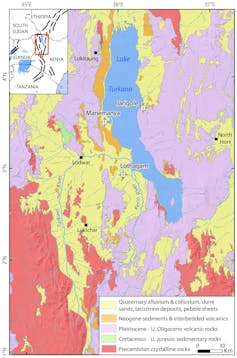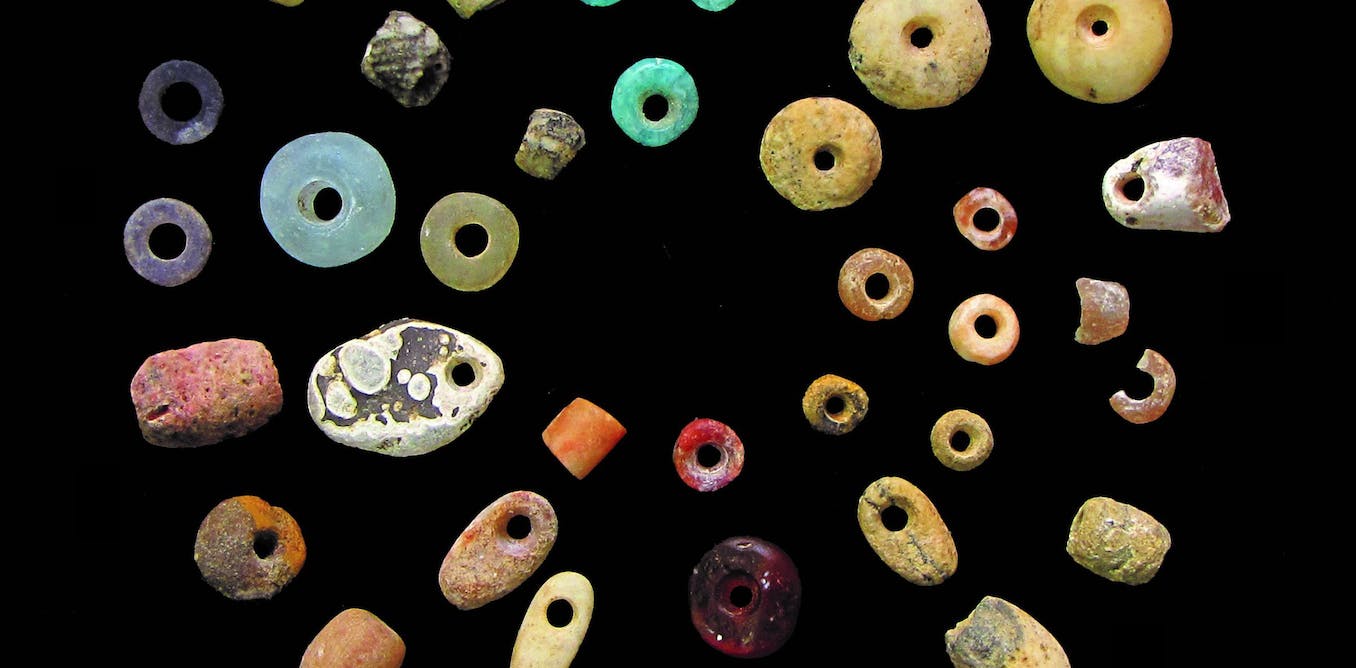On the shores of Lake Turkana in east Africa, about 5,000 to 4,000 years ago, pastoralists buried their dead in communal cemeteries that were marked by stone circles and pillars. The north-west Kenya “pillar sites” were built around the same time as Stonehenge in the UK. But these places have a different story to tell: about how mortuary traditions reflect people’s environments, behaviours and reactions to change.
The burial sites appeared at a time of major environmental and economic change in the region. The Sahara, which received enough rainfall 9,000-7,000 years ago to sustain populations of fisher-hunter-gatherers and pastoralists, was drying, causing groups of people to move east and south. Even in eastern Africa, lake levels were dropping dramatically; grassy plains were expanding. Around Lake Turkana, people began herding animals in addition to fishing and foraging.
At several of the pillar sites around Lake Turkana, archaeologists have found that hundreds of people were ceremonially interred under large, circular platform mounds. Many of those individuals were found wearing remarkable colourful stone beads, some as part of necklaces, bracelets, earrings, and other jewellery worn, for example, around the waist. These beautiful personal ornaments include blue-green amazonite, soft pink zeolite, deep red chalcedony, purple fluorite and green talc, among other minerals and rocks.
I study relationships between humans and their environments, especially at times of major economic transformations, using scientific techniques applied to archaeology. I recently led a team of experts in geology and archaeology of the region to conduct the first comprehensive mineralogical analysis of the Turkana stone beads.
The focus of our study was to discover what types of minerals and rocks the early herders had used to make adornments, and where these materials came from.
This kind of information can tell archaeologists about the role of artefacts in the society that used them.
Wearing beads
Humans have been making and wearing beads for over 140,000 years. Beads are one of the oldest forms of symbolism and are often used as adornment in a culture. Wearing something on your body is an expressive choice that can have many meanings, such as protection, acknowledgement of friendships and bonds, status or role in society. Personal ornaments like beads may indicate a common cultural understanding.
Analysis of beads in archaeological sites has shown that we can learn many things from them.
At the Turkana pillar sites, the stone bead tradition was clearly important, partly because of the number of beads found accompanying burials, and partly because the practice persisted for hundreds of years.
Knowing the range of materials helps us understand landscape use in the past: where people were buried, where they watered their animals, seasonal movements for grazing, special yearly trips to significant places and other movements. Pastoralists recorded or marked their worlds by what they left behind and what they took with them. Patterns in the composition of the bead collections may indicate there was communication and exchange of objects across the region.
Sorting the stone beads
Of the six pillar sites that have been excavated by archaeologists, three have yielded substantial assemblages of stone beads: Lothagam North, Manemanya and Jarigole. Our team began by sorting the stone beads by site, and by their mineral and rock types.
Our study identified the mineral characteristics of 806 stone beads. We looked at properties like specific gravity, crystal and molecular structure, and the characteristic emissions that are particular to certain minerals.
Carla Klehm, Author provided (no reuse)
What we found was a strikingly diverse set of beads that varied by site. The visual characteristics of some of the beads – colour, lustre and so on – may have made them particularly valuable or had a special meaning economically, socially, spiritually or symbolically. Their source and workability may also have given them a certain value.
Pink zeolites and turquoise amazonites were the most common stone beads at the site of Lothagam North, comprising over three-quarters of the assemblage. This was very similar to the site of Jarigole, located across the lake. The sites are hundreds of kilometres apart, with Lake Turkana in between – suggesting a cultural connection between them.

Carla Klehm, Author provided (no reuse)
In contrast, the kinds of beads at Manemanya were different: mostly softer and paler pink and off-white calcite beads that were quite large. Further, while at Lothagam North there often were just a few beads found with any individual, one person at Manemanya was buried with over 300 stone beads and over 10,000 ostrich eggshell beads.
This suggests that although having stone beads was a commonality across the sites, distinctions – and distinct meanings for different people – did exist.
Sourcing stones
We also wanted to know whether the beads were produced from local sources (within a few days’ walk) or acquired through long-distance journeys or trade. Sourcing allows us to partially reconstruct how the earliest pastoralists moved around the landscape during the year.
A survey of the areas west of Lake Turkana and a search of the published literature on the geology of the region identified places where these materials might have come from.

Carla Klehm. Map by Mark Helper
There are possible sources for most of these materials within about 150km of the pillar sites. Limestone rocks may have been procured easily near the lake. Some of the tougher materials, like the chalcedonies, could have been carried to the lake area by rivers, to be picked up perhaps by someone watering cattle or fetching water from a stream. Other minerals come from a specific source. The variety of bead types demonstrates that people knew their landscape well.
Sometimes, they went out of their way to get certain minerals, or perhaps traded for them. The closest known sources for amazonite and fluorite are, respectively, 225 km, in southern Ethiopia; and 350 km, near the modern city of Eldoret, Kenya.
These suggest that bead making was not just a casual affair; material selection was intentional.
Local landscapes
Early herders in the Turkana Basin obtained materials from both local and distant places, and shaped them into personal adornments. These stone beads were placed with the dead, in numbers and combinations that differed by individual and place. We don’t yet fully know what they meant – but future research in the Turkana Basin will continue to explore the lives and legacies of these pioneering herders as they negotiated new environmental and social landscapes.
Edits and comments for this article were provided by Late Prehistory of West Turkana project co-directors Drs. Elizabeth Hildebrand and Katherine Grillo, project minerologist Mark Helper, and Emmanuel Ndiema, who helped lead the sourcing study.



